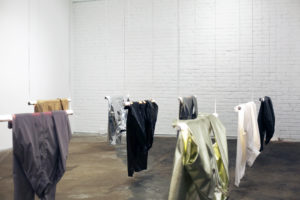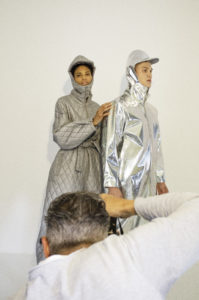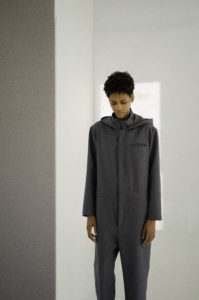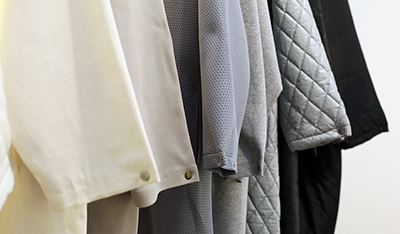You are in outer space right now, and your body is composed of stars …
That isn’t a metaphor—at least not for Christine Corday, the artist behind projects+gallery’s recent exhibition “SpacewalkerTM / +43F 14.7p.” Drawing inspiration both from astrophysics and the extraordinary physics of existing within a human body on Earth, Corday’s work uses the simple yet cosmologically immense tools of pressure and temperature to bend metal and minds. Following the scientific theme, her upcoming show at the Contemporary Art Museum St. Louis includes pieces from two bodies of work that explore gravity: “Primer Gray” and “Relative Points.”

“Spacewalker” at projects+gallery, November 17, 2017 – January 20, 2018
Your exhibit at projects+gallery was comprised of two shows. Spacewalker used wearable, perception-altering suits, light and temperature to encourage viewers to re-examine their embodied experience of their basic environment. +43F 14.7p, on the other hand, felt much more externally focused: It was comprised of immense, imposing iron forms that had nonetheless been made malleable by tremendous amounts of pressure and heat. Why did you pair these two works together?
Temperature and pressure, to me, are the hammer and chisel in my studio on a cosmological scale. For instance, the piece in +43F 14.7p that was shown at the front of the gallery was made of iron, and it was folded by a tremendous forge—literally the largest possible tool on earth—at 2,600 degrees Fahrenheit and 6,500,000 pounds of pressure per square inch. Basically, I was maxing out that tool.
Spacewalker was also informed by temperature and pressure, but there, it was the gravity of the room over the very subtle temperature of a light bulb. The suits were folded, too, using a much smaller amount of pressure. It’s a series of works that are specific to the temperature and pressure at the point in space at which they’re being worn and observed.

Photoshoot for Spacewalker™
And that point just happens to be on Earth.
Right. When we think of outer space, we’re thinking of things like Mars and the moon and other objects, but we don’t think of Earth in that way. And once we start to include the position of where we stand as also in space, we experience a different reorientation process. Exposing that bias and being able to focus one’s senses on that is an important part of the work.
You spent some time at NASA. What was your role there, and how did that experience impact this show?
I came to NASA as part of an internship, and I worked on a project there that was SETI-based. SETI stands for the Search for Extraterrestrial Intelligence, and basically, they use radio telescopes to search for other planets. My job was to plug away at the math using something called the stellar inclination theory in order to locate new stars beyond our current catalog. At the end of my project, I think I’d contributed something like 225 stars to that catalog.
So yeah, the whole experience got me very close to stars. And I think it made its mark with heat, too. Later, it was the heat of the foundry, and what I was seeing in the cauldrons of the foundries, that actually got me back into plasma science— plasma has definitely replaced my sense of paint—which then brought me back to stars. I guess I’ve always been a heat seeker, in that way.
What kind of reactions did you hear from your audience to this exhibit?
I think that the majority of reactions are more or less kind of the same revelation, it’s just always said in unique terms. That revelation comes from all of a sudden being able to see where you’re standing as if you’re in outer space.
And there’s one other aspect, too, which is that idea of no longer feeling insignificant. Regardless of where it comes from or how it’s indoctrinated or socialized or conditioned, there’s often a sense of human beings feeling insignificant in the scale of the universe, or in the scale of the cosmos. This work, again, is addressing that, because there’s great significance and there’s great definition, because you share a materiality with the universe. The iron in your blood, all of the elemental aspects that comprise your body, were forged in stars. And those stars were our own sun, and the suns before our own sun. There’s quite a material provenance—to use an art historical term—in that. To use matter as a line of sight, or more specifically, by using the elemental as a line of sight, one can automatically feel your own sense of significance, despite the scale.

Photoshoot for Spacewalker™
You have a show upcoming at CAM. Tell me about that work.
There are two bodies of work—one called Primer Gray, one called Relative Points. They’re using the materials of primer and iron compressions, respectively, but they’re both attempts to make gravity more sensate, and to point toward opening up our perceptory tools. As far as Earth is concerned, our senses have been evolving for the last million years; that’s quite a pace! And I love being able to slow down and grasp the scale of that pace. But our perceptory tools aren’t finished evolving, right? We’re evolving right now this very moment, even through our very fingertips. So all of these pieces point toward being able to focus the evolution of your perceptory system through this very moment into the next.
One of the things I’ve been interested in, if you’re kind of a science nerd, is that we’re kind of between what we call the third and fourth Copernican revolutions. The first one, of course, was the moment when we realized that not everything in the universe is revolving around the Earth, right? So that was a heretical bummer. But ever since then, we have been having to relocate our sense of spatial center more and more—and this is very very recent, actually: It wasn’t until the ‘40s, ‘50s and ‘60s that we realized that the Milky Way wasn’t the center of the universe. It’s pretty nuts, and after a while, we get tired of having to put something at the center if we only have to keep changing it. But the actual scientific fact of the matter is that if we have to agree to an actual, spatial center of the universe, then it’s everywhere and nowhere. I’m interested in that in these pieces: that whole reorientation to having to find comfort with a center that’s nowhere and everywhere.
For more about Spacewalker™, please visit the new website: https://spacewalkers.co
